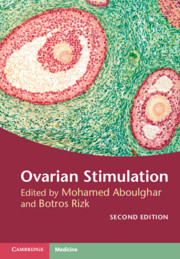39 results
About the Editors
-
- Book:
- Ovarian Stimulation
- Published online:
- 14 April 2022
- Print publication:
- 05 May 2022, pp xiii-xiv
-
- Chapter
- Export citation
Section 5 - Alternatives to Ovarian Hyperstimulation and Delayed Transfer
-
- Book:
- Ovarian Stimulation
- Published online:
- 14 April 2022
- Print publication:
- 05 May 2022, pp 223-264
-
- Chapter
- Export citation
Section 4 - Non-conventional Forms Used during Ovarian Stimulation
-
- Book:
- Ovarian Stimulation
- Published online:
- 14 April 2022
- Print publication:
- 05 May 2022, pp 189-222
-
- Chapter
- Export citation
Chapter 7 - Role of GnRH Antagonist in Assisted Reproduction
- from Section 2 - Ovarian Hyperstimulation for IVF
-
-
- Book:
- Ovarian Stimulation
- Published online:
- 14 April 2022
- Print publication:
- 05 May 2022, pp 65-78
-
- Chapter
- Export citation
Preface to the first edition
-
- Book:
- Ovarian Stimulation
- Published online:
- 14 April 2022
- Print publication:
- 05 May 2022, pp xvii-xviii
-
- Chapter
- Export citation
Section 3 - Difficulties and Complications of Ovarian Stimulation and Implantation
-
- Book:
- Ovarian Stimulation
- Published online:
- 14 April 2022
- Print publication:
- 05 May 2022, pp 109-188
-
- Chapter
- Export citation
Contents
-
- Book:
- Ovarian Stimulation
- Published online:
- 14 April 2022
- Print publication:
- 05 May 2022, pp vii-viii
-
- Chapter
- Export citation
Copyright page
-
- Book:
- Ovarian Stimulation
- Published online:
- 14 April 2022
- Print publication:
- 05 May 2022, pp iv-v
-
- Chapter
- Export citation
Dedication
-
- Book:
- Ovarian Stimulation
- Published online:
- 14 April 2022
- Print publication:
- 05 May 2022, pp vi-vi
-
- Chapter
- Export citation
Index
-
- Book:
- Ovarian Stimulation
- Published online:
- 14 April 2022
- Print publication:
- 05 May 2022, pp 319-330
-
- Chapter
- Export citation
Contributors
-
- Book:
- Ovarian Stimulation
- Published online:
- 14 April 2022
- Print publication:
- 05 May 2022, pp ix-xii
-
- Chapter
- Export citation
Section 1 - Mild Forms of Ovarian Stimulation
-
- Book:
- Ovarian Stimulation
- Published online:
- 14 April 2022
- Print publication:
- 05 May 2022, pp 1-54
-
- Chapter
- Export citation
Section 6 - Procedures before, during, and after Ovarian Stimulation
-
- Book:
- Ovarian Stimulation
- Published online:
- 14 April 2022
- Print publication:
- 05 May 2022, pp 265-318
-
- Chapter
- Export citation
Section 2 - Ovarian Hyperstimulation for IVF
-
- Book:
- Ovarian Stimulation
- Published online:
- 14 April 2022
- Print publication:
- 05 May 2022, pp 55-108
-
- Chapter
- Export citation
Preface to the second edition
-
- Book:
- Ovarian Stimulation
- Published online:
- 14 April 2022
- Print publication:
- 05 May 2022, pp xix-xx
-
- Chapter
- Export citation

Ovarian Stimulation
-
- Published online:
- 14 April 2022
- Print publication:
- 05 May 2022
Contributors
-
-
- Book:
- How to Improve your ART Success Rates
- Published online:
- 05 July 2011
- Print publication:
- 30 June 2011, pp viii-xii
-
- Chapter
- Export citation
Chapter 20 - Prevention of ovarian hyperstimulation syndrome
- from Section 3 - Stimulation
-
-
- Book:
- How to Improve your ART Success Rates
- Published online:
- 05 July 2011
- Print publication:
- 30 June 2011, pp 110-114
-
- Chapter
- Export citation
Section 4: - Non-conventional forms used during ovarian stimulation
-
- Book:
- Ovarian Stimulation
- Published online:
- 05 August 2011
- Print publication:
- 23 December 2010, pp 143-172
-
- Chapter
- Export citation
Ovarian Stimulation - Half title page
-
- Book:
- Ovarian Stimulation
- Published online:
- 05 August 2011
- Print publication:
- 23 December 2010, pp i-ii
-
- Chapter
- Export citation



